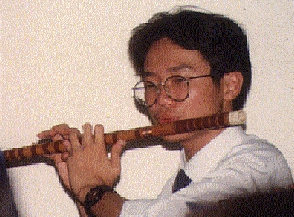The woodwind instruments consists of flutes, pipes and chinese trumpets. The woodwind section produces the loudest and highest pitch in the orchestra. The Percussions gives the music its life and rhythm and is thus the backbone of a chinese orchestra. Together, the woodwind and the percussions often highlights the climax of a music.
 Di
Zi (pronounced tee-ch),
the chinese bamboo flute.
Di
Zi (pronounced tee-ch),
the chinese bamboo flute. The Di Zi is available at different keys. Thus the Di Zi do not have a specific length. The length of the Di Zi varies to the keys they are tuned to. Thus a Di Zi in C-key is relatively longer than a Di Zi in F-key. There are also a piccolo sized Di Zi.
The player plays the flute by blowing across the mouth piece and produces different notes by stopping the six holes found on the rod. The sound of the Di Zi is very much similar to the flute and piccolo of the symphony orchestra.
Sheng, the chinese pipes.
The Sheng consists of several pipes of different lengths put together. It is played by blowing through a metal tube connected to a main chamber. It is at this chamber the air will rush through the pipes. The players determine which notes to play by allowing the air to rush through the selected pipes by pressing on the keys found near the chamber. This instrument is rather unique as it is the only instrument in the orchestra that can produce up to six notes at a time!
Suo Na (pronounced swo-na), the chinese trumpet.
The Suo Na functions like the brass instruments in the symphony orchestra. This instrument produces the loudest sounds in the orchestra. It is therefore always included in very grand music and it often supports the whole orchestra to the climax. The Suo Na have a "morning glory" shape and needs reeds,just like the oboe of the symphony orchestra. The instrument however sounds more like the trumpet.
There are hundreds of different percussions which can be used in the chinese orchestra. The main instruments are the drums, timpani, gongs and cymbals. For some songs bells, xylophone, tuned gongs and triangle are used.